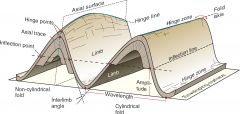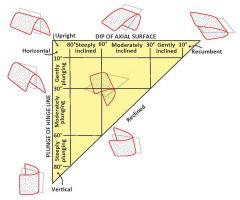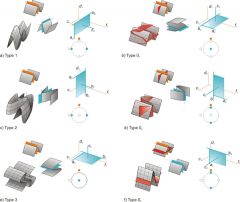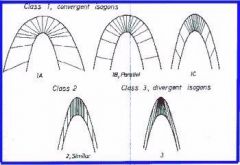![]()
![]()
![]()
Use LEFT and RIGHT arrow keys to navigate between flashcards;
Use UP and DOWN arrow keys to flip the card;
H to show hint;
A reads text to speech;
33 Cards in this Set
- Front
- Back
|
anticline |
fold that is convex in the direction of the youngest beds |
|
|
syncline |
Fold that is convex in the direction of the oldest beds |
|
|
synformal anticline |
upside down anticlinewith the oldest layers in the core |
|
|
antiformal syncline |
upside down synclinewith the youngest layers in the core |
|
|
monocline |
half fold with blind thrust fault |
|
|
anatomy of folds |

|
|
|
inflection point |
point of opposing convexity |
|
|
median surface |
imaginary surface connecting inflection lines |
|
|
hinge point |
point of maximum curvature, all points on a folded surface form a line |
|
|
axial surface |
imaginary surface formed by connecting hinge lines of all folded surfaces and bisects the fold |
|
|
interlimb angle |
measure of angle between limbs of fold |
|
|
symmetrical fold |
median surface and axial surface are perpendicular |
|
|
asymmetrical fold |
median and axial surfaces intersect at an oblique angle |
|
|
overturned fold |
one limb is facing down |
|
|
fold tightness |
Gental: 180-170 Open: 170-90 Tight: 90-10 Isoclinal: 10-0 |
|
|
orientation of axial fold |

Know this graph!!!! |
|
|
similar fold |
rocks folded at higher temp where ductile possible bed thinning in limbs, thickness in hinges |
|
|
concentric folds |
layer thickness does not change (lower T) |
|
|
cylindirical fold |
along-strike shape that approximatesa portion of a cylinder. a well-defined,linear fold axis |
|
|
non-cylindrical |
too complex to have asingle well-defined axial surface |
|
|
interference folds |

multiple generations of folds |
|
|
parasitic fold |
same orientation and geometry as big folds asymmetry of folds on limbs are mirror images symmetrical in center |
|
|
dip isogons |

connect equal dip on vertically oreinted folds Class 1: Isogons converge toward inner arc Class 2: Isogons parallel to axial trace (similar) Class 3: Isogons diverge toward inner arc |
|
|
flexural slip folding |
Folding is accommodated by slip along layer/bedding interfaces. The magnitude of slip increase from zero at the hinge to a maximum at the inflection point in the limbs |
|
|
Flexural Flow Folding |
Folding is accommodated by the plastic/ductile migration of material out of the high shear zones of the limbs into the low shear hinges. |
|
|
active folding or buckling |
fold profiles are based entirely on physical-mechanical properties of the layers Bucking occurs when a competentlayer in a less competent matrix is shortened parallel to the lengthof the layer. Buckling implies that there is a layer parallelshortening and a viscosity contrast involved, and alsoirregularities on which folds can nucleate. |
|
|
passive folding |
Generated by simple shearing are perfectly similar folds (class 2) |
|
|
forced folds or bending |
they just go along for the ride,and some of the beds happen to fined themselves in awkward places and are required to stretch or bend" 2-prominent types of forced folds:fault-bend folds and fault-propagation folds |
|
|
Passive folding |
Passive folding produces harmonic folds where thelayering plays no mechanical role and therefore noinfluence on the fold shape.
|
|
|
mechanisms for folding |
1. Flectural Folding: folding phone book -beds above move relative to beds below -Thin, low temp 2. Fectural Flow Folding: -similar folds -ductile shear -material migrate to low shear zones (hinges) 3. Active Folding/Buckling: -end loading & geometry is mechanical physical properties -competent layer in less competent matrix is shortened parallel to length of layer 4. Passive Folding: -folds occur to simple shear -velocity gradient Ex. glacier moving 5. Forced Folds: -Fault Bend Folds -Fault Propagation Folds - form as a result of motion upon faults. Beds are not free to fold, and they may or may not have significant layer-parallel stresses. Rather, they are somewhat passively going along for the ride - most often associated with faulting - all types. |
|
|
fault bend folds |
-ramp through comepetent units - thrust sheet migrates over plain - under fault doesn't move - slip is conserved. - Fold amplitude is determined by the thickness above the lower hanging wall flat.- Once the fold has achieved maximum amplitude, it only grows in width. !MOVIE! |
|
|
Fault propogation folds |
- blind fault propogates through surface - HW drives triangular zone over, pushes fold over - triangular zone is where deformation happens -FW is slightly deformed - after fault cuts through, stops deforming -fault slip is not conserved. Fault displacement is taken up by folding. Fault tip is marked by a ductile ‘process zone’. Ideally, FPF’s evolve into FBF’s |
|
|
thrust tip |
edge of fault plane where displacement become zero |

